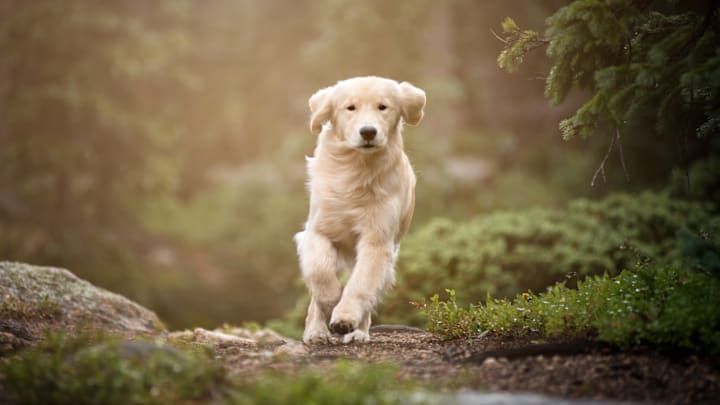It’s common knowledge that dogs are the domesticated descendents of wolves. Over many centuries, breeders have crossed selected pups to create new breeds with specific traits like high levels of intelligence, speed, and retrieval and hunting instincts. Today, there are hundreds of dog breeds, which can make tracing their origins difficult. Here’s what we know about the history of some of the most popular dog breeds.
- Labrador Retriever
- German Shepherd
- Golden Retriever
- English Bulldog
- French Bulldog
- Poodle
- Goldendoodle
- Labradoodle
- Pembroke and Cardigan Welsh Corgi
- Dachshund
- Chihuahua
Labrador Retriever

The Labrador retriever is known for its gentle temperament and water skills. Its origins date back to the 18th century, when colonizers from France, Portugal, Spain, and Britain brought small water dog breeds to Newfoundland. Those animals then mated with local dogs over time, creating the St. John’s dog breed. This new type of dog was then brought to Poole, England—via ships, which let the canines show off their swimming skills—and were bred to eventually create the Labrador retriever. The Labrador retriever remains a popular dog breed today; the St. John’s dog, however, went extinct in the 1980s.
German Shepherd

German shepherds owe their existence to Captain Max Emil Frederick von Stephanitz, a student at Berlin Veterinary College who decided he wanted to breed the perfect shepherd pup in the late 1800s. He noticed a medium-sized dog at a show that exhibited many of the qualities—sheep herding, intelligence, and speed—he was looking to breed.
The dog, Horand von Grafrath, was already the result of several generations of careful breeding, and he quickly became the superstar of the captain’s program. Horand von Grafrath is known as the first German shepherd; most members of his breed can trace their lineage back to him.
Golden Retriever

Golden retrievers are best known for their friendly temperaments, their hunting skills, and their reputation as great guide dogs. There are several theories about how this popular dog breed came to be. We know golden retrievers originated in Scotland in the 19th century, but exactly how remains up for debate. Some believe the pups are descendants of Romanian Circus Dogs that a man Sir Dudley Marjoribanks purchased and bred with bloodhounds.
Another theory was inspired by Marjoribanks’s own records, which showed that he purchased a yellow retriever named Nous in 1865. After working with the dog for a while, Marjoribanks bred him with a tweed water spaniel; those offspring were crossed with breeds like bloodhounds, Irish setters, and the St. John’s water dog to create the golden retriever.
English Bulldog

One of the earliest literary references to the English bulldog dates to around 1500. William Shakespeare mentioned the breed, which was also known as the “Bandog” in one of his plays; the first formal mention of a “bulldog” occurs in a letter from 1631. The earliest versions of the dogs were put to work fighting bulls.
The English Bulldog likely descended from a match made between the Asiatic mastiff and the pug. Although this breed was beloved for many years, it almost entirely disappeared when bull baiting (or bullfighting) was banned in England in 1835. Some bulldog owners pivoted from treating the dogs like livestock guardians to adopting them as pets or members of a breeding program, allowing their popularity to bounce back.
French Bulldog

French bulldogs actually originated in England. English lacemakers during the Industrial Revolution liked small, lap-sized bulldogs. As those lacemakers made their way to France, the small bulldogs went with them. The wrinkly-faced canines were crossed with other breeds over time. According to the American Kennel Club, French bulldogs as we know them are a mix of English bulldogs and other breeds, likely terriers and pugs.
Poodle

The origins of the poodle are muddled. Although it is difficult to determine where the breed’s first ancestors came from, it’s likely they either descended from a German water dog or the French barbet. Most history buffs agree that the first poodles emerged in Germany.
Goldendoodle

Goldendoodles are technically crossbreeds, but that doesn’t make them any less popular. Goldendoodles’ ancestors came from Australia and North America relatively recently. Monica Dickens—a descendant of Charles Dickens—began crossing golden retrievers with poodles in the late 1960s to create a hypoallergenic dog (though there’s no such thing as a truly hypoallergenic pup) with a tranquil attitude.
Labradoodle
Goldendoodles aren’t the only crossbreed that has become wildly popular in recent decades. Wally Conron mixed a Labrador retriever with a poodle in 1989 to create a hypoallergenic guide dog for a woman from Hawaii. Conron later stated that he regretted ever creating the Labradoodle. “I opened a Pandora’s box and released a Frankenstein[’s] monster,” he told the Australian Broadcasting Corporation in 2019.
Pembroke and Cardigan Welsh Corgi

The corgi, a favorite of the late Queen Elizabeth II, is generally believed to be the only native herding dog from Wales. This dog’s history is much longer than most, dating back to the 11th century. The Pembroke and the Cardigan Corgis have similar appearances and qualities, although the Pembroke’s ancestors were from spitz dogs (a type of canine with wolf-like features), while the Cardigan Corgi came from the teckel (Dachshund) bloodline.
Dachshund

Dachshunds were created in Germany to hunt badgers, and they’re believed to have descended from a mix of terriers, pointers, and hounds. Though the dachshund’s origins can be traced back to the 15th century, the breed as we know it today really started to take shape in the 17th century.
Chihuahua
Chihuahuas, named after the Mexican state, descended from the Techichi, a type of canine the Toltec people kept as far back as the 9th century. Although the Chihuahua is one of the smallest dog breeds on the planet, it’s also a mighty one. The Aztecs widely believed that the Chihuahuas would offer guidance in the afterlife.
Read More Stories About Dogs Here:
